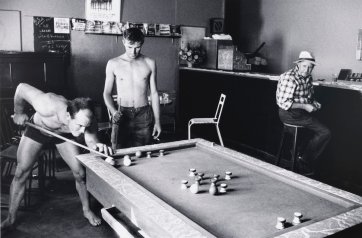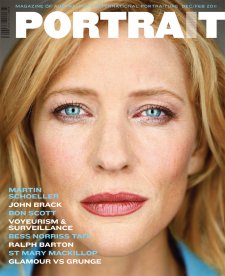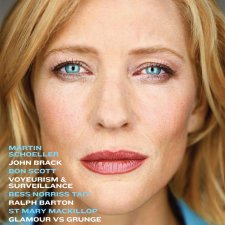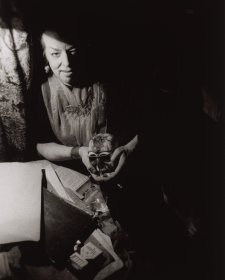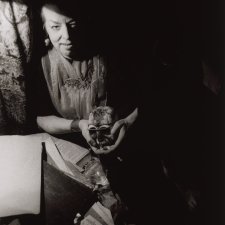Bon Scott wasn’t with AC/DC when the band formed in 1973. He died before they recorded Back in Black – the world’s all-time second-best-selling album – in 1980. All the same, it’s a fair bet that asked to name the lead singer of AC/DC, a great many Australians would have to stop themselves from answering ‘Bon Scott’ – and have to grope for the name of his inspired replacement, Brian Johnston.
The National Portrait Gallery has recently acquired a photograph of Bon Scott and Angus Young, taken by Rennie Ellis on AC/DC’s American tour in 1978. Ellis was in the USA filming a documentary, Australian Music to the World, reporting on the success of expatriate performers including Helen Reddy and Barry Crocker. In the process, he took some classic shots of AC/DC. One shows Angus, bare-chested in performance in Los Angeles; another, taken in Atlanta, Georgia, captures Bon flirting backstage. A third is this rare glimpse of the young bandmembers simply excited to be where they were at the time. Shirtless male figures began appearing in Australian photographs in the interwar years, but the Gallery’s mandate to collect images of ‘known and named’ individuals has precluded its acquiring Max Dupain’s iconic photographs Sunbaker 1937 or Form at Bondi 1939. Olive Cotton’s frankly sexy shot of Dupain towelling down, Max after Surfing 1937, has been on temporary display at the National Portrait Gallery, but is not represented in the collection.
Images of well-muscled, smooth-skinned males abound in advertising today, yet the sight of men barebellied in public is startling, if not downright shocking. Forty or fifty years ago, when no men appeared topless in magazines or on billboards, they were everywhere to be seen in real life – in slowly-passing cars, at barbecues, at the cricket, in the takeaway. In the 1970s, sprinklers were moved, cars were washed and lawns mowed without a shirt (let alone protective eyewear or earmuffs, which were barely obtainable in any case). Builders’ labourers and council workers went about their tasks in shorts, socks and boots alone. Bob Hawke horsed around the ALP National Conference in trunks that would now be deemed indecent outside the context of competitive swimming events; Dennis Lillee’s chest hair was framed, rather than concealed, by his white cotton cricket shirt. At the Rugby League Grand Final of 1974, the victorious captain Arthur Beetson stood beside the Governor General bare chested and with an opponent’s jersey slung around his neck. Darryl Braithwaite sang ‘Summer Love’ in 1975 in a silky waistcoat, flapping undone against his skin, and prolonged the look through 1976, leaving various satin garments unfastened through a string of videoclips. Shirley Strachan sang ‘Ego is not a Dirty Word’ wearing only braces, bow tie and wristwatch above the waist. Against stiff competition from AC/DC, Strachan’s band, Skyhooks, were remarkably lewd, even by today’s standards. Strangely enough, it was Sherbet, tame by comparison, who posed nude – albeit coyly entwined – for Lewis Morley in 1974.
To celebrate summer and the acquisition of the photograph of Scott and Young the National Portrait Gallery has gathered on display other shirtless photographs, including David Moore’s unsettling Bar billiards 1963; Anderson and Low’s sub-aqua 1999 portrait of Michael Klim, Murray Rose, Jon Henricks and John Devitt 1955 by Ern McQuillan; and John Witzig’s photographs of Midget Farrelly at Palm Beach in 1966 and Nat Young in Hawaii in 1967. Also presented in this display is late dancer Russell Page, artists Michael Johnson in his factory studio, and John Bell posing in his hat in an old Sydney building in 1968.
Rugged-up for contrast on this wall is Wayne Lynch, universally ranked in the all-time top ten surfers. Through his youth Lynch was no doubt topless as often as he was clothed. Here, however, his work done, he was snapped by Edward Sawden after his victory at Bells Beach in 1968, wearing his medal, intensely alive, and looking as if he’d never grow old.

